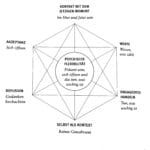Imagine navigating life’s inevitable ups and downs with more grace and resilience. The ACT Hexaflex offers a powerful framework for achieving just that. It’s a guide to cultivating psychological flexibility, empowering you to live a life aligned with what truly matters.
Understanding the ACT Hexaflex
The ACT Hexaflex is a core component of Acceptance and Commitment Therapy (ACT), a type of therapy that emphasizes acceptance, mindfulness, and values-based action. It’s a visual representation of six core processes that work together to promote psychological flexibility. Think of it as a roadmap to navigating challenges with greater ease and purpose. If you want to know more about the history and how to use ACT Hexaflex in the clinical setting, you can read our article about it.
The Six Core Processes
These six processes aren’t meant to be tackled in a rigid sequence, but rather cultivated and practiced over time. They’re interconnected facets of a single approach to well-being.
Acceptance: This involves making peace with difficult thoughts, feelings, and sensations without judging or trying to control them. It’s not about liking these experiences, but about acknowledging their presence and allowing them to exist without dictating your actions.
Cognitive Defusion: Our minds are constantly generating thoughts, some helpful, some not. Cognitive defusion is about recognizing thoughts as just thoughts—mental events, not facts. It’s about creating distance between yourself and your thoughts, preventing them from dominating your experience.
Present Moment Awareness: This means engaging fully with the here and now, tuning into your current experience without judgment. It’s about savoring the richness of each moment, rather than getting lost in regrets about the past or worries about the future.
Self-as-Context: This involves recognizing that you are more than just your thoughts and feelings. You are the observer, the context in which these experiences occur. This perspective can provide a sense of stability and perspective, especially during challenging times.
Values: Your values are your guiding compass, representing what truly matters to you. They might include things like connection, creativity, or contribution. Identifying your values provides direction and purpose.
Committed Action: This is about taking concrete steps towards living a life aligned with your values, even when it’s difficult. It’s about showing up for what matters to you, even in the face of obstacles.
These processes interact dynamically, fostering what’s known as psychological flexibility. This isn’t about bending over backward or becoming passive; it’s about developing the ability to navigate life’s inevitable ups and downs with resilience, grace, and a commitment to living in accordance with what truly matters to you.
Delving Deeper into ACT
ACT, a third-wave Cognitive-Behavioral Therapy (CBT), aims to improve psychological flexibility by emphasizing acceptance, mindfulness, and values-based action. It’s not about eliminating difficult experiences, but rather changing your relationship with them, allowing you to live a more fulfilling life. The hexaflex isn’t just a static model, but a tool for cultivating these skills. Learn more about how VCV words relate to emotions.
The 4 A’s of ACT
While the Hexaflex represents the six core processes, sometimes ACT is also explained through the 4 A’s, another helpful lens for understanding how ACT works on a practical level.
Acknowledge: Notice your inner experiences—thoughts, feelings, sensations—without judgment. Simply recognize their presence.
Allow: Give yourself permission to feel whatever you’re feeling. Don’t resist or fight your inner experience.
Accommodate: Adjust your behaviors to make room for difficult feelings, so they don’t derail your life or prevent you from taking valued action.
Appreciate: Recognize that even challenging emotions can provide valuable lessons and opportunities for growth.
These 4 A’s build psychological flexibility, empowering you to live a richer life, even amidst difficult experiences. It’s an ongoing journey, supported by ongoing research and constantly evolving understanding within the field.
The Science Behind the ACT Hexaflex
Bach & Moran (2008) introduced the hexaflex as a visual aid for clinicians, helping therapists guide their clients. The model emphasizes the interconnectedness of thoughts, feelings, and behaviors, addressing client problems holistically. This interconnectedness is key to understanding ACT’s effectiveness; each process supports the others, creating a synergistic effect. While much research supports ACT and the hexaflex, it’s important to recognize that research is ongoing. This field is constantly evolving, and our understanding of these processes continues to deepen.
Putting the Hexaflex into Practice
The ACT Hexaflex offers a structured approach to applying ACT principles in your daily life. It helps you:
- Manage difficult emotions: By practicing acceptance and cognitive defusion, you can learn to relate to challenging emotions differently, reducing their impact on your life.
- Clarify your values: The Hexaflex guides you towards identifying what truly matters, providing a sense of purpose and direction.
- Take effective action: By connecting your actions to your values, you’re more likely to engage in behaviors that lead to a fulfilling life.
- Build resilience: The Hexaflex equips you with the skills to navigate setbacks and challenges with greater ease and flexibility.
Addressing Misconceptions and Limitations
It’s important to address some common misconceptions about ACT and the Hexaflex. ACT is not about passive resignation or giving up. Acceptance is not about condoning or liking difficult situations; it’s about creating space for them while still pursuing what matters to you.
While the Hexaflex is a powerful model, it may not be suitable for everyone. It’s essential to consult with a qualified mental health professional to determine if ACT is the right approach for your needs. It’s also important to acknowledge that ACT is still a relatively new therapy, meaning more research is needed to fully understand its mechanisms and long-term effects. However, current research suggests its potential for positive change.
Connecting with Other Approaches
The ACT Hexaflex aligns with other mindfulness-based therapies that emphasize present moment awareness, acceptance, and non-judgment. These connections can further broaden your understanding and provide additional resources for exploring these concepts.
The ACT Hexaflex provides a comprehensive roadmap for cultivating psychological flexibility, offering practical tools for navigating life’s challenges with greater resilience and purpose. While research continues to evolve our understanding of these processes, the potential benefits of embracing the Hexaflex are substantial. It empowers you to take the reins of your inner world and create a life rich in meaning and purpose.
- Unlock 6000+ words beginning with he: A comprehensive analysis - April 20, 2025
- Mastering -al Words: A Complete Guide - April 20, 2025
- Master Scrabble: High-Scoring BAR Words Now - April 20, 2025

















1 thought on “Harness the Power of the ACT Hexaflex: Your Guide to Psychological Flexibility”
Comments are closed.